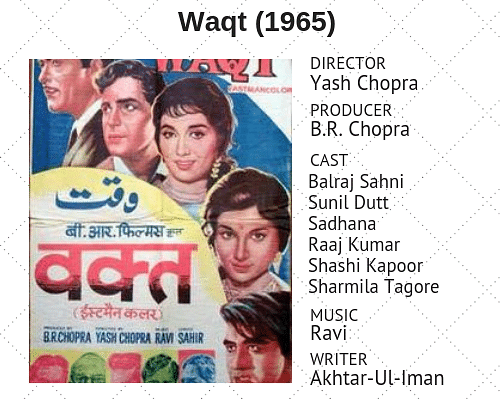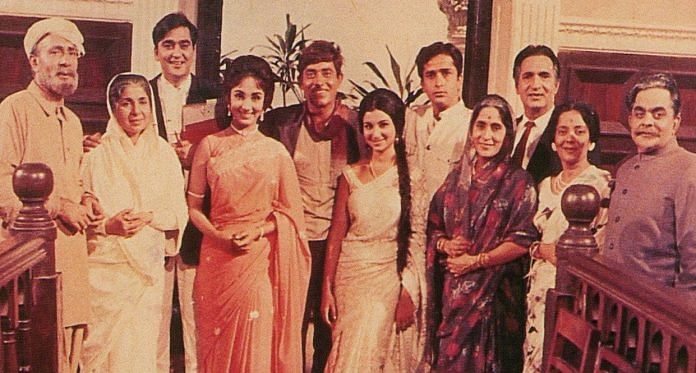Yash Chopra’s Waqt had it all: Family, love triangles, multiple stars, hit music and a courtroom.
There was a man who gave one Bollywood blockbuster that defined every decade of Indian cinema, and his name is Yash Chopra. If he was alive, he would have turned 86-years-old on 27 September.
 In 1965, he directed a film for his brother B.R. Chopra that established his own style and changed his fortunes forever – Waqt.
In 1965, he directed a film for his brother B.R. Chopra that established his own style and changed his fortunes forever – Waqt.
It was the Kabhi Khushi Kabhie Gham of its time. Waqt was Hindi cinema’s first multi-starrer, which became its immediate identity. The biggest success of 1965, Waqt set the bar for all major commercial filmmakers in its portrayal of love and fate with flair, and flaunting a certain bigness of heart with glamour.
After two strong and ‘bold’ social dramas, Yash Chopra found a thematically solid film in a repurposed lost-and-found story by F.A. Mirza (screenplay by B.R. Chopra and dialogue by Akhtar Ul Iman).
The story of Waqt begins with a middle-aged dry fruits merchant Lala Kedarnath (Balraj Sahni) in what appears to be pre-Partition Punjab, though there is no explicit mention of such. In an early scene to delineate the theme of the film, Kedarnath argues with an astrologer over the control of a man over his own fate. The astrologer says, “Waqt insaan se kab kya karaye, ye nahin kaha ja sakta Lalaji (You never know what time will make you do).”
https://www.youtube.com/watch?v=WsGi81kMcho
Within minutes, an earthquake strikes (said to be a reference to the 1935 Quetta earthquake) and Kedarnath’s family – his three sons and wife – splinters and separates. While the youngest son Vijay remains with mother Laxmi (Achala Sachdev), the middle Ravi is found by a couple who adopts him and the eldest Raja ends up in an orphanage.
Years later, the lives of the three brothers and their parents intersect again.
Also read: Narendra Modi’s gutter remark makes one want to watch ‘Jaane Bhi Do Yaaro’ again
Trust Chopra to find a love triangle involving two lost brothers – Raja (Raaj Kumar) and Ravi (Sunil Dutt) – in a family drama. Raja, a thief, falls in love with Meena (Sadhana) who is in love with family friend and lawyer Ravi. The three share an engaging romantic track that features it all, including a car-race sequence that would be thrilling even in a James Bond film.
In Waqt, ‘Jaani’ Raaj Kumar gets the film’s and his own career’s most remembered line, spoken to a henchmen wielding a knife, “Ye bachchon ke khelne ki cheez nahi, haanth kat jaaye to khoon nikal aata hai (This is not for kids’ play. If you get a cut, it bleeds)”. His brooding, rakish intensity dominates every scene he appears in.
In contrast, Dutt walks the thin line between being charming and irritating but largely comes out unscathed. In a rare, well-defined plot for a Hindi film, the other three leads don’t get the same love, especially Sadhana whose wardrobe appears to be the centre focus.
Bhanu Athaiya (who later won an Oscar for Gandhi) designed the film’s costumes and invested it with unprecedented style for Hindi audiences. (There is a swimsuit scene too, which can, most certainly, be called unconventional for its time.)
Also read: Amar Akbar Anthony is the perfect thematic prequel to Mulk
In Chopra’s wall-to-wall narrative carpeting with glamour and lifestyle (though never garish), the most textured element was composer Ravi’s music, with lyrics by Sahir. From ‘Aye Meri Zohra Jabeen’ to ‘Kaun Aaya Ki Nigahon Me Chamak’ to ‘Hum Jab Simat Ke Aapki’, the album remains as memorable as ever.
https://www.youtube.com/watch?v=3B8XioZy6mc
Chopra’s cinematic storytelling was larger than life and yet somehow managed to be relatable and aspirational at the same time. He could pull off what could appear ridiculous and yet retain the integrity of the film.
Waqt had every trope: love, fate, family, separation, longing, hill station duets, murder, a dead body hidden in a closet and a suspenseful courtroom sequence.
It is in the courtroom that the family finally reunites.
In Waqt, designed to illustrate the uncertainties and impermanence of life and times, the director shot some of his best work in the spellbinding ‘Aage Bhi’. Using an unusual crooner device, with tension enveloping the narrative, Chopra filmed incredible compositions (including visible cuts). In this slow, haunting song sequence multiple storylines unfold.
Chopra elevated the wonderful lyrics of the legendary Sahir –Aage Bhi Jaane Na Tu, Peeche Bhi Jaane Na Tu… Jo Bhi Hai, Bas Yahi Ek Pal Hai (You don’t know the future, you don’t know the past… Whatever it is, it’s just this moment) – to say everything that needed to be said.
Also read: Ankhen, India’s first big spy film had a Doctor, Madam, Captain, and of course, Lily
It’s difficult to find a parallel to Yash Chopra in Bollywood. He was the sultan of romance. A romance that became synonymous with chiffon saris in the Swiss Alps. He made his last film Jab Tak Hai Jaan in 2012. And ironically, he died of dengue in Mumbai before he could shoot a portion of the title track of the film in Switzerland. It was the kind of signature plot twist his own films were made of.




That’s the worst possible insult to Waqt! It’s like comparing ‘Sholay’ to ‘RamGopal Varma Ki Aag’
A true classic, great music, sublime romance (also observed later in Kabhie Kabhie as Amitabh flirts with Rakhee while giving her his autograph), excellent court scenes, and a superbly integrated script. One of the top 25 films for sure (sorry, but KKKG is trash by comparison). However, the most important insight gained from examining the works of Yash Chopra is that his genius towers puts a glaring spotlight on the mediocrity of both his sons.
Part of our growing up years in Old Delhi, very close to Guide. Aaj kal aisi filmein kyon nahin banti … 2. If memory serves me right, while talking about his three sons, Balraj Sahni, an incredibly handsome man, says one of the three is a little dim, like me, and then he turns out to be the brightest.